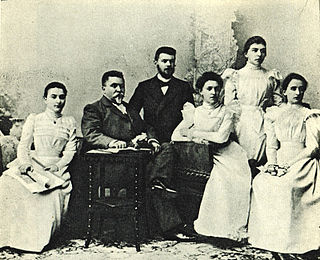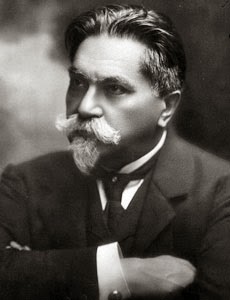- Profession: Pianist, conductor.
- Residences: St Petersburg, Moscow, New York.
- Relation to Mahler:
- Correspondence with Mahler:
- Born: 06-02-1852 Ishcherskaya (Itschory, Itsyursk, or Itsiursk), Chechnya.
- Died: 27-02-1918 Kislovodsk, Russia. Aged 66.
- Buried:
Russian pianist and conductor, born Vasily Ilyich Safonov (??????? ????? ???????); also known outside Russia as Wassily Safonoff. Safonov was the son of a Cossack general who left the Caucasus in 1862 to settle in St Petersburg. Here Vasily attended the prestigious Lyceum at nearby Tsarskoye Selo and took piano lessons with Teodor Leszetycki (1830–1915). Like Tchaikovsky, he began his career in the civil service. After seven years Safonov resigned his post and enrolled at the St Petersburg Conservatory in 1879, where he studied music theory under Nikolay Zaremba and piano with Louis Brassin, graduating with a gold medal in 1880.
After a spell teaching at the St Petersburg Conservatory, he became professor of piano at the Moscow Conservatory in 1885 on Tchaikovsky’s recommendation. In 1889 he succeeded Sergey Taneyev as the conservatory’s director. Although Tchaikovsky initially welcomed this appointment, recognising Safonov’s skills as an administrator, he began to believe that the latter’s style was too autocratic and disrespectful of the traditions of the institution.
In particular, Tchaikovsky was angered by Safonov’s decision not to appoint Anatoly Brandukov as the successor of Wilhelm Fitzenhagen upon the latter’s untimely death in 1890. Brandukov had been a loyal friend of Nikolay Rubinstein, and Tchaikovsky felt that he deserved the post of cello professor at the Conservatory far more than Safonov’s appointee Alfred von Glenn. These differences of view led to Tchaikovsky’s resignation as a director of the Russian Musical Society (RMS) in Moscow.
Subsequent relations between the two men improved to an extent, and at the RMS concert in Moscow on 14/26 February 1893 conducted by Tchaikovsky, Safonov played the celesta in the orchestral suite from The Nutcracker ballet (in the Dance of the Sugar Plum Fairy). The unusual sound of this instrument caused a strong impression on the audience, and at the end of this concert Safonov asked the composer if they could patch up their earlier quarrel. Tchaikovsky agreed and later that year he dedicated his piano piece Méditation (No. 5 of the Eighteen Pieces, Op. 72) to Safonov. The latter was a genuine admirer of Tchaikovsky’s music and after the composer’s death Safonov would conduct the first official performance in Moscow of the Pathétique on 4/16 December 1893.

Vasily Safonov (1852-1918) with his pupils from the Moscow Conservatory (from left to right): Rosina Lhévinne, Alexander Goedicke, Elena Beckman-Shcherbina, Olimpiada Kartasheva and Aglaida Fridman.
In 1889 Safonov succeeded Max Erdmannsdörfer as principal conductor of the Russian Musical Society concerts in Moscow, where in his later years he was one of the first conductors to dispense with a baton. After being invited to New York as guest conductor of the Philharmonic Society Orchestra in 1904, he returned to become its sole conductor from 1906 to 1909, while concurrently serving as director of the National Conservatory of Music in the city. After returning to Russia in 1909, he resumed his conducting position with the RMS in Moscow (where he remained until 1912), and also performed in chamber ensembles. In 1916 his guide to piano technique, entitled A New Formula (????? ???????) was published in Russian and English.
More
Ilji’? Safo’nov, also known as Wassily Safonoff, was a Russian pianist, teacher, conductor and composer. Vasily Safonov, or Safonoff as he was known in the West during his lifetime, was born at Ishcherskaya (also known as Itschory, Itsyursk, or Itsiursk), Russian Caucasus (now in Chechnya), son of the Cossack General Ilya Ivanovich Safonov. Vasily was educated at the Imperial Alexandra Lyceum, Saint Petersburg, and at the Saint Petersburg Conservatory of Music 1881-1885 under Louis Brassin. He graduated as Bachelor of Laws, and won the gold medal as a pianist of the Conservatory. He was also a pupil of Theodor Leschetizky and Nikolai Zaremba.
Safonov was never a particularly successful composer in his own right, but was a master music educator, becoming Director of the Moscow Conservatory in 1889. He was the director of the National Conservatory of Music in New York. He was the teacher of some of the best Russian pianists, notably Alexander Scriabin, Nikolai Medtner, Josef Lhévinne and Rosina Bessie (later Lhévinne). He was also a teacher of Marthe Servine, a French-American composer and pianist.
After retiring from teaching, Safonov became well known as a conductor. He was the conductor of the first Moscow performance of Tchaikovsky’s Pathétique Symphony (No. 6), on 4/16 December 1893, seven weeks after its premiere under the composer’s baton and six weeks after his death.
He conducted nearly all the principal orchestras in Europe, including the Philharmonic Orchestras of Berlin, Vienna and Prague, the Lamoureux Orchestra of Paris, the London Symphony, the Orchestra dell’Accademia Nazionale di Santa Cecilia and the New York Philharmonic Society. Safonov is the first known modern conductor to have dispensed with the use of the baton, which came about when he forgot to take his baton to a rehearsal on a certain occasion; he chose to use his hands alone, and decided that from then on a baton was entirely unnecessary.

